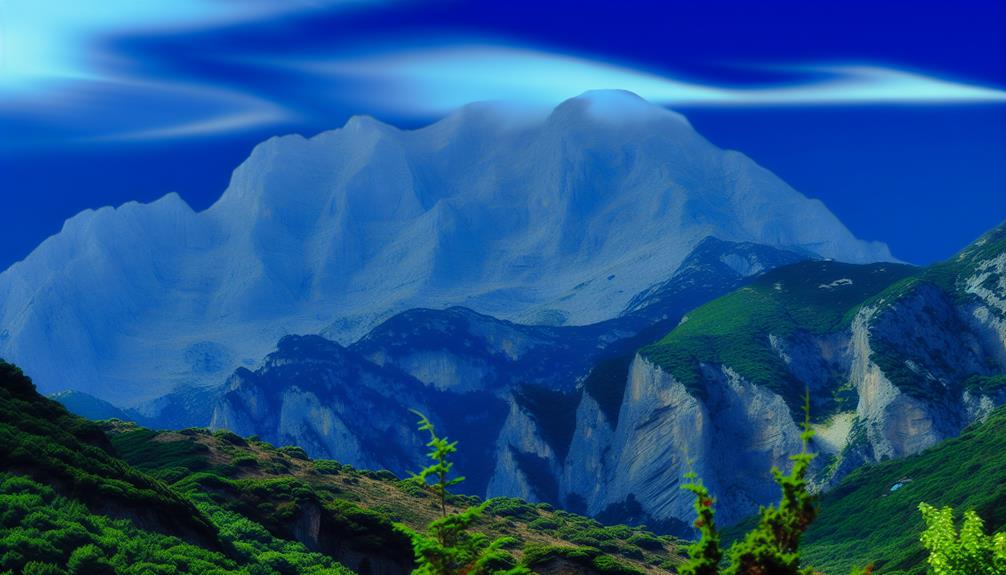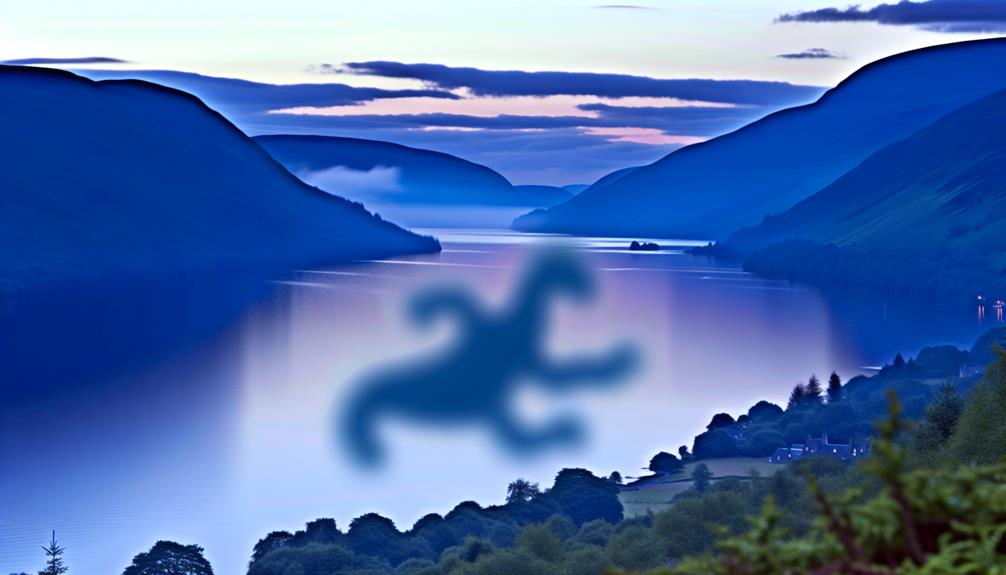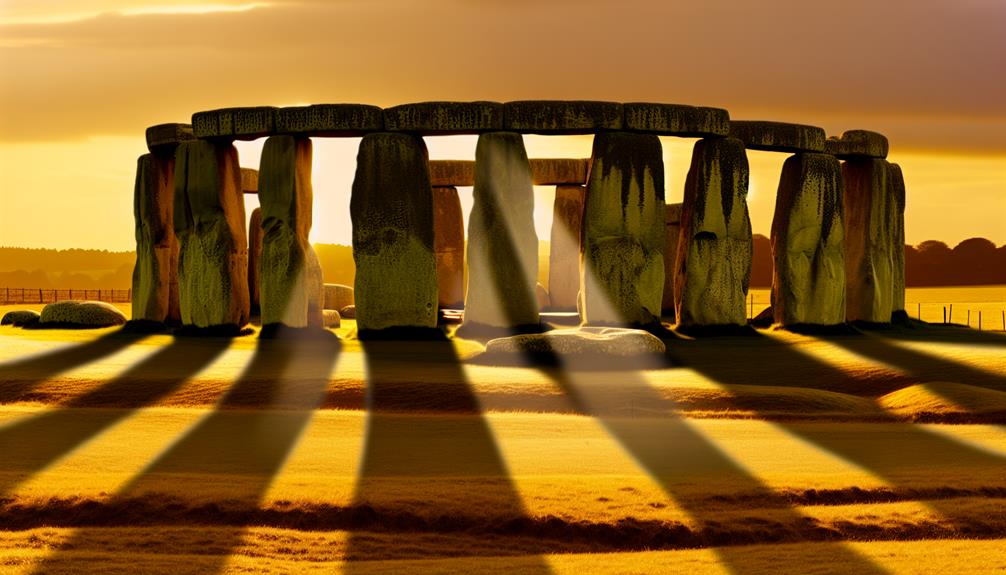Nestled in the heart of Greece, Mt. Olympus stands as a stoic sentinel, a silent witness to the ebb and flow of time. Its towering peaks and craggy cliffs have long been shrouded in myth and mystery, beckoning explorers and scholars alike to uncover the secrets hidden within its rugged embrace. As the sun sets over this ancient dominion, casting long shadows across its rocky slopes, one cannot help but wonder about the untold tales that lie dormant in its ancient stones, waiting to be unearthed by those daring enough to venture into its domain.
Key Takeaways
- Mt. Olympus is linked to the Twelve Olympian gods in Greek mythology.
- It symbolizes the cradle of Western civilization and intersects the earthly and divine.
- The mountain offers scenic hiking trails, climbing challenges, and diverse flora and fauna.
- Local legends and mythical creatures like centaurs enrich the mountain's allure.
- Ecotourism opportunities and adventure activities promote sustainability and cultural exchange.
Mythical Origins
According to ancient Greek mythology, the mythical origins of Mt. Olympus trace back to the belief that this majestic mountain served as the dwelling place of the Twelve Olympian gods, presiding over the world below from their divine abode. In the Theogony tales, attributed to the poet Hesiod, it is depicted that the primordial deities Gaia and Ouranos gave birth to the Titans, who, in turn, birthed the Olympian gods. This genealogy placed the Olympian gods at the zenith of the divine hierarchy, with Mt. Olympus chosen as their celestial residence.
The Ancient myths surrounding Mt. Olympus not only highlighted its physical grandeur but also imbued it with immense symbolic significance. The mountain's lofty peaks and perpetual shroud of clouds were believed to shield the gods from mortal eyes, adding to its mystique and awe-inspiring presence. The Greeks viewed Mt. Olympus as the axis mundi, the center of the cosmos where the earthly and divine intersected.
These Theogony tales and Ancient myths underscore the deep reverence and importance that Mt. Olympus held in the religious and cultural imagination of the ancient Greeks. The association of this towering peak with the abode of the Twelve Olympian gods served to elevate its status to a place of divine power and authority, shaping the spiritual beliefs and practices of the ancient Hellenic world.
Pantheon of Gods
The Pantheon of Gods in ancient Greek mythology comprised a diverse assembly of deities, each possessing distinct roles and attributes within the divine hierarchy. At the zenith of this pantheon stood the twelve Olympian gods, led by Zeus, the king of gods and ruler of the sky. Each deity had a domain and a set of powers, shaping the mythical stories and beliefs of the ancient Greeks.
Zeus, known for his thunderbolt, presided over the heavens and was the enforcer of justice. Poseidon, the god of the sea, wielded a trident and controlled the waters. Athena, the goddess of wisdom and warfare, emerged fully armed from Zeus' head. Aphrodite, the goddess of love and beauty, had the power to influence emotions and desires.
The pantheon also included gods like Apollo, the god of light, music, and healing; Artemis, the goddess of the hunt and wilderness; and Hermes, the messenger of the gods. These deities interacted with humans, often intervening in their lives and shaping destinies based on their divine powers.
Mythical stories were woven around the interactions and conflicts among these gods, reflecting human emotions, virtues, and flaws. The pantheon's influence extended to various aspects of Greek life, from art and literature to governance and warfare, making the gods central figures in the cultural and religious landscape of ancient Greece.
Scenic Hiking Trails
Nestled amidst the ancient splendor of Mt. Olympus in Greece are a network of scenic hiking trails that offer unparalleled views of the majestic landscape. These trails wind their way through the rugged terrain, providing hikers with spectacular vistas at every turn. As you ascend the slopes of Mt. Olympus, you are greeted with nature's wonders in the form of lush forests, cascading waterfalls, and diverse flora and fauna.
One of the most popular trails is the Enipeas Gorge Trail, known for its breathtaking scenery and unique geological formations. Hikers can witness the raw power of nature as they trek alongside the Enipeas River, which has carved its way through the mountains over millennia.
For those seeking a more challenging adventure, the Path of the Gods offers a thrilling experience with its steep ascents and panoramic views of the surrounding valleys. This trail is not for the faint of heart but rewards those who dare to conquer it with unparalleled beauty.
Whether you are an experienced hiker or a casual nature enthusiast, Mt. Olympus has a hiking trail suited to your preferences. Each path promises an immersive experience in nature's grandeur, allowing you to connect with the ancient spirit of this legendary mountain.
Flora and Fauna
Amidst the expanse of Mt. Olympus in Greece thrives a diverse array of flora and fauna, contributing to the mountain's ecological richness.
The Greek biodiversity found on Mt. Olympus is truly remarkable, encompassing a wide variety of plant and animal species. Let's explore the mountain wildlife that makes this region so special:
- Himalayan Blackberry (Rubus armeniacus): This invasive plant species has taken root on Mt. Olympus, impacting the native vegetation and ecosystem.
- Eurasian Wolf (Canis lupus lupus): Known for its elusive nature, the Eurasian Wolf roams the slopes of Mt. Olympus, playing an essential role in the mountain's ecosystem.
- Balkan Chamois (Rupicapra rupicapra balcanica): A species of goat-antelope, the Balkan Chamois is well-adapted to the rugged terrain of Mt. Olympus.
- European Pine Marten (Martes martes): This elusive forest-dwelling mammal can be found in the dense woodlands of Mt. Olympus.
- Balkan Goldenring Dragonfly (Cordulegaster heros): An impressive insect species, the Balkan Goldenring Dragonfly flits around the streams and rivers of Mt. Olympus, adding to the mountain's biodiversity.
The unique combination of Greek biodiversity and mountain wildlife on Mt. Olympus creates a harmonious ecosystem that deserves admiration and protection.
Historical Significance
Within the annals of history, Mt. Olympus stands as a monumental site of profound historical significance, holding a legacy that transcends time and borders. This majestic mountain in Greece has been intertwined with mythical tales and revered as the dwelling place of the ancient Greek gods. The rich tapestry of Greek mythology portrays Mt. Olympus as the seat of Zeus, the king of the gods, and the Pantheon of other deities.
Moreover, beyond its mythological importance, Mt. Olympus boasts ancient ruins that bear witness to its historical significance. The archaeological remains scattered around the mountain serve as a confirmation of its past glory and the human civilizations that once inhabited these sacred slopes. The ruins provide valuable insights into the religious practices, societal structure, and architectural prowess of the ancient Greeks.
The historical significance of Mt. Olympus extends beyond its immediate geographical boundaries. It symbolizes the cradle of Western civilization and serves as a cultural touchstone for people around the world. The enduring allure of Mt. Olympus lies not only in its physical grandeur but also in the layers of history and mythology that shroud its peaks. As visitors explore the mountain and contemplate its mythical tales and ancient ruins, they become part of a narrative that has shaped human imagination for centuries.
Local Legends
Enriching the historical fabric of Mt. Olympus, Greece, are a myriad of local legends that have been passed down through generations, adding layers of mystique to this revered mountain.
- Folklore Tales: One popular legend tells of the ancient gods making their home on Mt. Olympus, where they held grand feasts and decided the fate of mortals.
- Hidden Treasures: Locals whisper about hidden caves within the mountain that are said to contain untold riches and artifacts from centuries past.
- Supernatural Encounters: Visitors have reported feeling a mystical presence or hearing ethereal voices while traversing the mountain's trails, adding to its mystical allure.
- Mysterious Sightings: Some claim to have seen shadowy figures darting between the trees or witnessed strange lights dancing on the peaks under the cloak of night.
- Mythical Creatures: According to legend, mythical creatures such as centaurs and nymphs roam the slopes of Mt. Olympus, occasionally revealing themselves to those deemed worthy.
These folklore tales of gods, hidden treasures, supernatural encounters, mysterious sightings, and mythical creatures contribute to the enchanting aura surrounding Mt. Olympus, captivating both locals and visitors alike with the allure of the unknown and the magic of ancient stories.
Climbing Challenges
Traversing the rugged terrain and unpredictable weather conditions on Mt. Olympus presents climbers with a series of formidable challenges that demand skill, endurance, and careful planning. Rock climbing on Mt. Olympus is a test of both physical and mental strength. The mountain offers a variety of routes ranging from moderate to extremely difficult, catering to climbers of all skill levels. However, even the more accessible paths require a high level of fitness and technical proficiency due to the steep inclines, loose rocks, and narrow passages.
Endurance is key when facing the climbing challenges of Mt. Olympus. The ascent can be grueling, with climbers often facing long hours of continuous exertion. Proper pacing and stamina are essential to successfully reach the summit. Additionally, the weather on the mountain is known to change rapidly, adding another layer of complexity to the climb. Climbers must be prepared for sudden shifts in temperature, strong winds, and potential storms.
To overcome these challenges, climbers must engage in thorough preparation. This includes studying the route, understanding the weather patterns, and packing adequate supplies. Safety should always be the top priority when attempting the rock faces of Mt. Olympus. By respecting the mountain and being well-equipped, climbers can turn this endurance test into a rewarding and unforgettable experience.
Ecotourism Opportunities
Exploring the diverse flora and fauna while adhering to sustainable practices, Mt. Olympus offers compelling ecotourism opportunities for nature enthusiasts seeking an immersive experience in this breathtaking natural environment.
- Guided Nature Walks: Engage in educational hikes led by local experts, learning about the unique plant species and wildlife conservation efforts in the region.
- Community Homestays: Immerse yourself in the local culture by staying with host families, participating in their daily activities, and supporting community-based ecotourism initiatives.
- Bird Watching Excursions: Discover the rich avian diversity of Mt. Olympus through guided bird watching tours, contributing to ongoing wildlife conservation projects.
- Organic Farm Visits: Experience sustainable agriculture practices firsthand by visiting organic farms in the area, understanding the importance of biodiversity conservation.
- Environmental Workshops: Attend workshops focused on sustainability, wildlife conservation, and eco-friendly practices, actively engaging in efforts to protect the natural beauty of Mt. Olympus.
Modern-Day Exploration
In the contemporary context, an examination of modern-day exploration on Mt. Olympus reveals a dynamic interplay between adventurous pursuits and sustainable practices in the quest to unravel the mountain's alluring charm. Adventure seekers flock to Mt. Olympus not only for its breathtaking landscapes but also for the thrill of conquering its peaks. However, this surge in visitors has led to concerns about preserving the mountain's pristine environment and cultural heritage. To address these challenges, a balance between adventure tourism and sustainable practices is essential.
| Aspects | Description | Benefits |
|---|---|---|
| Adventure Activities | Mt. Olympus offers a range of activities such as hiking, rock climbing, and paragliding, attracting thrill-seekers from around the globe. | – Boosts local economy<br>- Provides employment opportunities |
| Cultural Immersion | Travelers can immerse themselves in the rich history and mythology surrounding Mt. Olympus, engaging with local traditions and customs. | – Promotes cultural exchange<br>- Preserves traditional practices |
| Sustainable Tourism | Initiatives promoting responsible tourism practices aim to minimize environmental impact and protect the mountain's biodiversity. | – Preserves natural habitats<br>- Reduces carbon footprint |
Frequently Asked Questions
Can Visitors Witness Any Archaeological Excavations on Mt. Olympus?
Excavation findings provide valuable insights into past civilizations, offering a window into ancient cultures and historical developments. Archaeological discoveries often uncover artifacts, structures, and remnants that help reconstruct the lives of our ancestors.
Witnessing such excavations can be a unique and educational experience, allowing visitors to observe firsthand the meticulous process of unearthing and interpreting these remnants. This exposure fosters a deeper appreciation for the importance of preserving and understanding our shared history.
Are There Any Traditional Festivals Celebrated on the Mountain?
Local traditions and customs often include festive celebrations and rituals that hold significant cultural and historical importance. These events bring communities together, fostering a sense of unity and belonging.
Through traditional festivals, people honor their heritage, ancestors, and shared values, passing down stories and practices from generation to generation.
These celebrations play an essential role in preserving cultural identity and strengthening social bonds within societies.
Is There a Specific Time of Year When Meteor Showers Are Visible?
To observe meteor showers, the best time of year is during peak shower dates. Usually, the Perseids peak in August and the Geminids in December. Ideal locations away from city lights offer the best visibility.
To capture stunning meteor shower photographs, use a tripod, wide-angle lens, and set a long exposure with a high ISO. Patience and clear skies are key for successful meteor shower photography.
Are There Any Restrictions on Camping or Picnicking in the Area?
Camping regulations and picnic guidelines are vital components of managing recreational areas. These rules are typically put in place to guarantee the safety and preservation of natural habitats. Regulations may include designated camping areas, restrictions on open fires, waste disposal guidelines, and quiet hours.
Picnic guidelines often focus on waste disposal, designated areas, and respecting wildlife. Compliance with these rules is essential for maintaining the integrity of the environment and ensuring a positive experience for all visitors.
What Unique Rock Formations Can Be Found on Mt. Olympus?
Unique geology often captivates explorers, and ancient myths add a layer of mystique. Intriguing rock formations such as hoodoos, natural arches, or balanced rocks can be found in various regions worldwide.
These geological wonders, shaped by natural forces over eons, inspire awe and curiosity. Linking these formations to ancient myths can deepen our appreciation for the Earth's history and cultural significance, enriching our understanding of the world around us.
Conclusion
To sum up, Mt. Olympus in Greece stands as a monumental evidence to the intersection of myth, history, and natural beauty. Its towering presence and rich cultural significance make it a must-visit destination for those seeking to immerse themselves in the timeless narrative of ancient gods and heroes.
The mountain's allure transcends mere physicality, offering visitors an unparalleled experience that elevates their understanding of Western civilization's origins. A journey to Mt. Olympus is not just a hike, but a transformative odyssey through the depths of human imagination.


